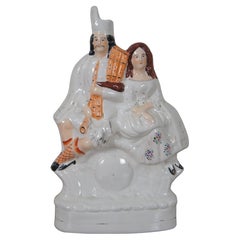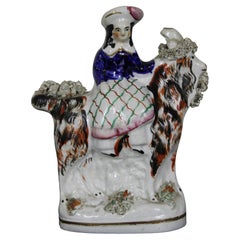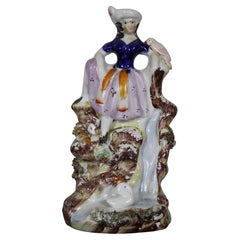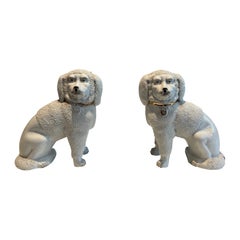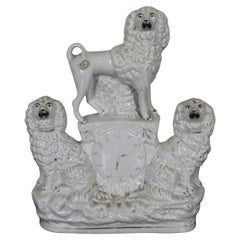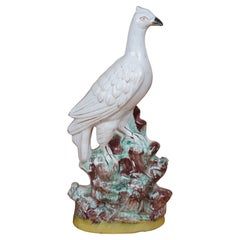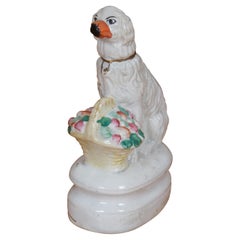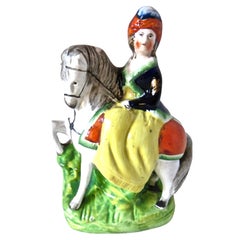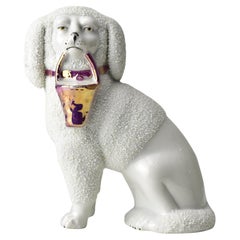Staffordshire Porcelain Figurines
Antique 1870s Victorian Figurative Sculptures
Porcelain
Antique 19th Century Victorian Figurative Sculptures
Porcelain
Antique 19th Century British Colonial Figurative Sculptures
Porcelain
Antique 19th Century British Victorian Animal Sculptures
Porcelain
Antique 19th Century Victorian Animal Sculptures
Porcelain
Antique 19th Century Victorian Animal Sculptures
Porcelain
Antique 19th Century Victorian Animal Sculptures
Porcelain
Antique 1880s Victorian Figurative Sculptures
Porcelain
Antique 1860s English Victorian Animal Sculptures
Porcelain
Vintage 1950s English Victorian Porcelain
Ceramic, Paint
Early 20th Century British Late Victorian Figurative Sculptures
Porcelain
Antique Mid-19th Century English Early Victorian Animal Sculptures
Porcelain, Paint
Antique 19th Century Victorian Figurative Sculptures
Porcelain
Antique 19th Century Victorian Figurative Sculptures
Porcelain
Antique 19th Century Victorian Figurative Sculptures
Porcelain
Antique 19th Century Victorian Animal Sculptures
Porcelain
Early 20th Century Figurative Sculptures
Porcelain
Antique 19th Century Victorian Figurative Sculptures
Porcelain
Antique 19th Century Victorian Figurative Sculptures
Porcelain
Antique Mid-19th Century Victorian Figurative Sculptures
Porcelain
Antique 19th Century Victorian Figurative Sculptures
Porcelain
Antique 19th Century Victorian Figurative Sculptures
Porcelain
Antique 19th Century Victorian Figurative Sculptures
Porcelain
Antique 1890s English Figurative Sculptures
Porcelain
Antique 19th Century Victorian Figurative Sculptures
Porcelain
Antique 19th Century Victorian Figurative Sculptures
Porcelain
Antique 19th Century Victorian Figurative Sculptures
Porcelain
Antique 19th Century Victorian Figurative Sculptures
Porcelain
Antique 19th Century Victorian Figurative Sculptures
Porcelain
Antique 19th Century Victorian Figurative Sculptures
Porcelain
Antique 19th Century Victorian Figurative Sculptures
Porcelain
Antique 19th Century Victorian Figurative Sculptures
Porcelain
Antique 19th Century Victorian Figurative Sculptures
Porcelain
Antique 19th Century Victorian Vases
Porcelain
Antique 19th Century Victorian Figurative Sculptures
Porcelain
Antique 19th Century Victorian Table Lamps
Porcelain, Hardwood
Antique 19th Century Victorian Table Lamps
Porcelain, Hardwood
Antique 19th Century Victorian Vases
Porcelain
Antique 19th Century Victorian Table Lamps
Porcelain, Hardwood
Early 20th Century Victorian Animal Sculptures
Porcelain
Antique Mid-19th Century English Porcelain
Porcelain
Antique Mid-19th Century English Victorian Figurative Sculptures
Porcelain
Antique Late 19th Century English Victorian Figurative Sculptures
Porcelain
Antique Mid-19th Century English Porcelain
Porcelain
Antique 19th Century Victorian Figurative Sculptures
Porcelain
Antique 19th Century Victorian Figurative Sculptures
Porcelain
Antique Late 19th Century Victorian Animal Sculptures
Porcelain
Early 20th Century British Colonial Animal Sculptures
Porcelain
Antique 19th Century Figurative Sculptures
Porcelain
Antique Late 19th Century Victorian Animal Sculptures
Porcelain
Antique 19th Century Victorian Animal Sculptures
Porcelain
Antique 19th Century Victorian Animal Sculptures
Porcelain
Antique Late 19th Century British Victorian Animal Sculptures
Porcelain
Antique Mid-19th Century English Victorian Figurative Sculptures
Porcelain
Antique Late 19th Century English Late Victorian Figurative Sculptures
Porcelain
Mid-20th Century British Colonial Animal Sculptures
Porcelain
Antique Late 19th Century Victorian Animal Sculptures
Porcelain
Antique 19th Century Victorian Animal Sculptures
Porcelain
- 1
Staffordshire Porcelain Figurines For Sale on 1stDibs
How Much are Staffordshire Porcelain Figurines?
Finding the Right Sculptures for You
Styling your home with vintage, new and antique sculptures means adding a touch that can meaningfully transform the space. By introducing a sculptural work as a decorative finish to any interior, you’re making a statement, whether you tend toward the dramatic or prefer to keep things casual with modest, understated art.
A single, one-of-a-kind three-dimensional figurative sculpture mounted on your dining room wall is a guaranteed conversation piece, while a trio of abstract works arranged on your living room bookshelves can add spontaneity to the collection of first-edition novels or artist monographs you’re displaying as well as draw attention to them. Figurative sculptures are representational works that portray a specific person, animal or object. And while decorating with busts, which are sculpted or cast figurative works, hasn’t exactly topped the list of design trends every year, busts are back. According to designer Timothy Corrigan, “They give humanity in a way that a more abstract sculpture can’t give.” Abstract sculptures, on the other hand, are not meant to show something specific. Instead, they invoke a mood or scene without directly stating what they are portraying.
Busts made of stone or metal may not seem like a good fit for your existing decor. Fortunately, there are many ways for a seemingly incongruous piece to fit in with the rest of your room’s theme. You can embrace a dramatic piece by making it the focal point of the room, or you can choose to incorporate several elements made out of the same material to create harmony in your space. If an antique or more dramatic piece doesn’t feel like you, why not opt for works comprising plastic, fiberglass or other more modern materials?
When incorporating sculpture into the design of your home — be it the playful work of auction hero and multimedia visionary KAWS, contemporary fiber art from Connecticut dealer browngrotta arts or still-life sculpture on a budget — consider proper lighting, which can bring out the distinctive aspects of your piece that deserve attention. And make sure you know how the size and form of the sculpture will affect your space in whole. If you choose a sculpture with dramatic design elements, such as sharp angles or bright colors, for example, try to better integrate this new addition by echoing those elements in the rest of your room’s design.
Get started on decorating with sculpture now — find figurative sculptures, animal sculptures and more on 1stDibs today.
- 1stDibs ExpertApril 5, 2022No. In fact, most Staffordshire figurines are not marked. Staffordshire figurines made from 1740 to the mid-1900s don’t generally have a maker’s mark, since they were produced by unknown, small manufacturers. Those manufactured by Kent between 1944 and 1962 feature a black printed mark that reads “Staffordshire Ware Kent Made in England.” Shop a collection of Staffordshire figurines from top sellers on 1stDibs.
- 1stDibs ExpertMarch 22, 2022To tell if Staffordshire figurines are real, turn them over. An authentic Staffordshire will have a hole in the base due to the press-molded firing technique. Also, artisans hand-painted the figurines, so no two ever show off the exact same variations in color. Staffordshire didn't add maker's marks to their pieces. If you see a name on a decorative object, it is unlikely to be authentic. Find a collection of expertly vetted Staffordshire figurines on 1stDibs.
- 1stDibs ExpertNovember 26, 2024To identify Staffordshire porcelain marks, first look to see if your piece has a loosely knotted rope logo. Some items produced in Staffordshire bear this mark. Many pieces also feature a second or alternate maker's mark corresponding to the factory that produced it, such as Spode, Minton and Wedgwood. Online reference guides published on trusted websites can help you determine who made your piece based on these markings. Keep in mind that some Staffordshire porcelain is completely unmarked. If you can't locate a marking, consider having a certified appraiser or knowledgeable antique dealer assist you. Explore a wide variety of Staffordshire porcelain on 1stDibs.
- 1stDibs ExpertApril 5, 2022The term ceramic is a generic term that refers to something that is made of clay and solidified through heat. Porcelain falls under the ceramic umbrella, but it incorporates kaolin as an ingredient, creating a white clay. To determine if a figurine is porcelain or stoneware or earthenware, it’s best to examine it. Porcelain is somewhat translucent with a glasslike surface where there is no glaze. Shop a range of antique and vintage porcelain figurines on 1stDibs.
- 1stDibs ExpertSeptember 9, 2024To tell vintage porcelain figurines apart from other pieces, look on the bottom for a maker's mark. Then, consult trusted online resources to determine the approximate time when the manufacturer produced pieces similar to yours. It is vintage if your figurine was manufactured between 20 and 99 years ago. Older figurines are antique, while newer ones are contemporary. A certified appraiser or knowledgeable dealer can also assist with the dating and identification process. Shop a wide range of vintage figurines on 1stDibs.
- 1stDibs ExpertApril 5, 2022One thing to look for in an antique porcelain figure is to look for the maker’s mark, usually found on the bottom of the piece. The porcelain figure will also have a delicate fragile quality to it. On 1stDibs, find a collection of antique porcelain figures from some of the world’s top sellers.
- 1stDibs ExpertApril 5, 2022The difference between porcelain and ceramic figurines is the materials used to produce them. Porcelain is a delicate white material, while ceramic tends to be heavier and varies in color depending on the type of clay used to produce it. Shop a wide range of antique and vintage figurines on 1stDibs.
- 1stDibs ExpertMarch 22, 2022No, every Fornasetti porcelain figurine is handmade. In fact, the brand produces all of their home decorative items by hand at their workshop in Milan, Italy. If you see indications that a figurine came from a factory, it is likely not an authentic Fornasetti. Shop a collection of expertly vetted Fornasetti on 1stDibs.
